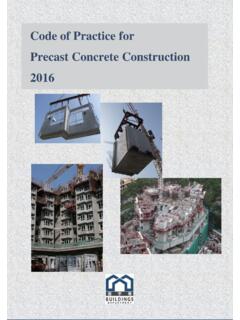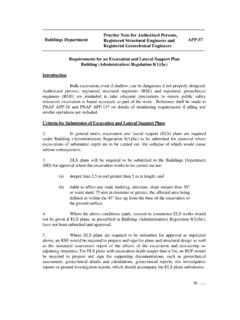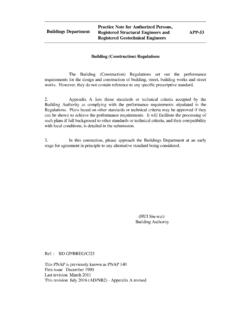Transcription of Practice Note for Authorized Persons, Registered ...
1 Buildings Department Practice Note for Authorized Persons, Registered Structural Engineers and Registered Geotechnical Engineers APP-152 Sustainable Building Design Guidelines This Practice note promulgates guidelines on building design which will enhance the quality and sustainability of the built environment in Hong Kong. These guidelines are the Sustainable Building Design Guidelines (SBD Guidelines) referred to in Practice Note for Authorized Persons, Registered Structural Engineers and Registered Geotechnical Engineers (PNAP) APP-151, the compliance with which the Building Authority (BA) will take into account, where applicable, as a pre-requisite in exempting or disregarding green and amenity features and non-mandatory / non- essential plant rooms and services from gross floor area and/or site coverage calculations (GFA concessions)
2 For new building developments. Terminology used in the SBD Guidelines is listed in Appendix A. Objectives 2. The SBD Guidelines establish 3 key building design elements to enhance the environmental sustainability of our living space. They are building separation , building setback and site coverage of greenery. The objectives are to achieve better air ventilation, enhance the environmental quality of our living space, provide more greenery, particularly at pedestrian level; and mitigate the heat island effect. Building separation 3. In order to improve air ventilation, enhance the environmental quality at pedestrian level and mitigate heat island effects arising from the undesirable screening effect of long buildings at different levels, building sites of the following categories should comply with the building separation requirements: (a) sites that are 20,000m2 or above ; or (b) sites that are less than 20,000m2 and proposed with building or group of buildings having a continuous projected fa ade length (Lp) of 60m or above .
3 4. Building separation requirements for each assessment zone: (a) Design Requirement (1) Lp The Lp of a building or group of buildings along a street should not exceed the maximum permissible1 which is calculated based on 5 times the mean width of street canyon (U); and /(b) .. 1 See Appendix B for computation of maximum permissible Lp 2 (b) Design Requirement (2) Separating Distance (S) and Permeability (P) (i) The P, comprising a minimum of 2/3 Intervening Space (IS) and a maximum of 1/3 Permeable Element (PE), assessed on two vertical projection planes for the two categories of sites should not be less than those as shown in Table 1.
4 (ii) Along the chosen projection planes, the S for the IS between the projected fa ade of the building and the site boundaries or the centreline of adjoining streets / lanes should not be less than wide; and (iii) If such IS are not sufficient to meet 2/3 of the P, additional IS with S not less than 15m wide can be provided between 2 projected building fa ades for making up. Table 1 Minimum P of buildings in each assessment zone on two projection planes Height (H) of the tallest building Site area < 20,000m2 and with Lp 60m Site area 20,000m2 Each Plane Plane 1 Plane 2 H 60m 20% 20% 25% H > 60m 20% 20% Detailed requirements and method of measurement on Lp, S and P are given in Appendix B.
5 6. Standalone residential building blocks of height not exceeding 15m can be exempted from the building separation requirements and disregarded in the assessment of such for other buildings. Building Setback 7. In order to improve air ventilation, enhance the environmental quality at pedestrian level and mitigate street canyon effect, buildings fronting a street less than 15m wide should be set back to comply with one of the following requirements: (a) For maintaining a ventilation corridor with minimum section of 15m x 15m, no part of the building up to a level of 15m above the street level should be within from the centreline of the street as shown in Figures C1 and C2 of Appendix C.
6 Where level of a street varies, the minimum sectional area should be kept along the full frontage following the profile of the street. /(b).. 3 (b) Where a cross-ventilated communal podium garden with a clear height of not less than is provided, no part of the building up to a level of 15m above the street level, should protrude above the 45o inclined plane, the base of which is placed at street level at the site boundary line on the opposite side of the street as shown in Figures C3 and C4 of Appendix C. Typical examples on the application of building setback requirements are given in Figures C5 to C9 of Appendix C.
7 8. In determining the compliance with the setback requirement, the BA may take into account the following factors: (a) Structures higher than 15m above the street level may be allowed to build over the setback area2. If the setback area is uncovered, a canopy that complied with regulation 10 of the B(P)R may be permitted; (b) Minor projecting features and signboards projecting not more than 600mm from the external walls and at a clear height of not less than above the street level; and single-storey footbridges across the setback area may also be permitted; (c) Columns supporting the building above may be permitted within the setback areas subject to requirements as shown in Figure C2 of Appendix C.
8 And (d) The setback area should be properly landscaped and paved, and be open without any permanent building structures other than landscaped features, perforated balustrades, perforated boundary walls and structural columns. 9. Buildings may be exempted from whole or parts of the building setback requirement with reference to a street where its height3 is less than 2 times the mean width of the street. Site Coverage of Greenery 10. In order to improve the environmental quality of the urban space, particularly at the pedestrian level and to mitigate the heat island effect, sites with areas of 1,000m2 or more should be provided with greenery areas in accordance with Table 2.
9 Detail guidelines are provided in Appendix D. 2 The setback area at ground level under the footprint of such structures or the covered areas under the canopy may be exempted from GFA calculation if it is designated as common parts accessible by occupants of the building and without any commercial activities. 3 Height of the building in this context is measured from the mean level of the street on which the building abuts to the mean height of the roof over the highest usable floor space in the building. 4 Table 2 Site Area Minimum Site Coverage of GreeneryPrimary zoneOverall1,000 m2 20,000 m210%20% 20,000 m215%30%11.
10 This requirement is not applicable to sites with a single family house only. Special Considerations 12. There are special circumstances in which genuine difficulties in complying with the SBD Guidelines may be encountered. Examples include new buildings serving special functions such as ferry piers, railway terminals, stadia; and conversion of existing buildings to new buildings especially the adaptive reuse of historic buildings where building fa ades or even layout are character defining elements. In recognition of such genuine constraints in meeting the prescriptive requirements, the BA takes a flexible and pragmatic stance when considering applicants proposals holistically to achieve the objectives of the SBD Guidelines.









